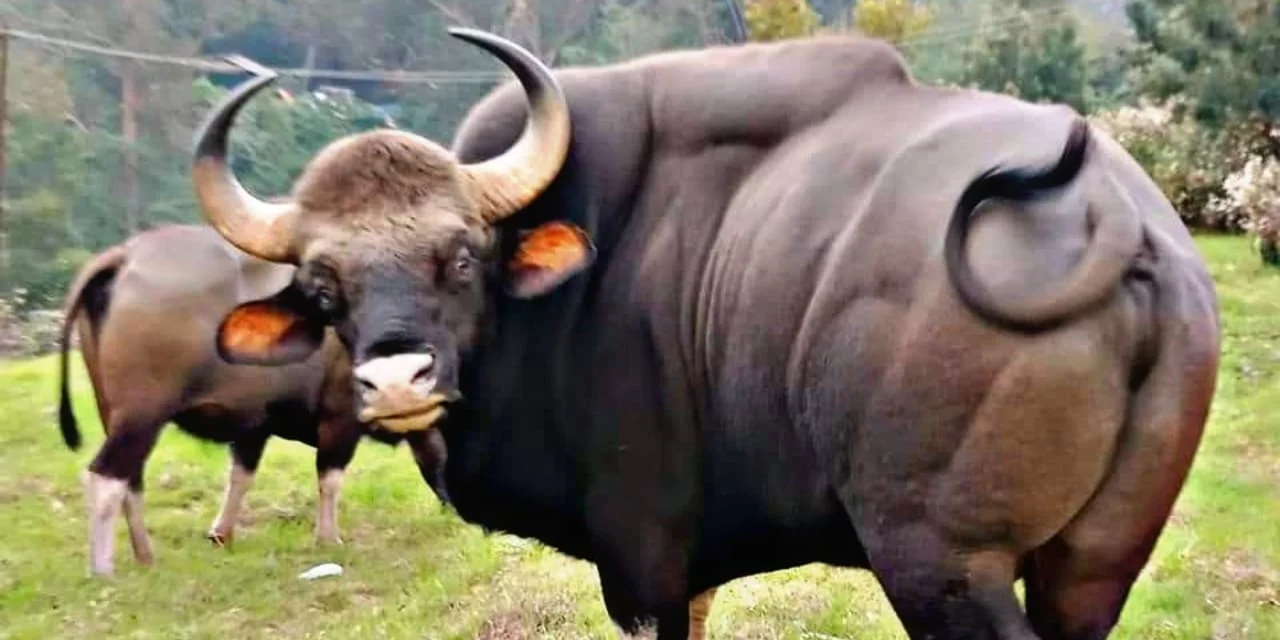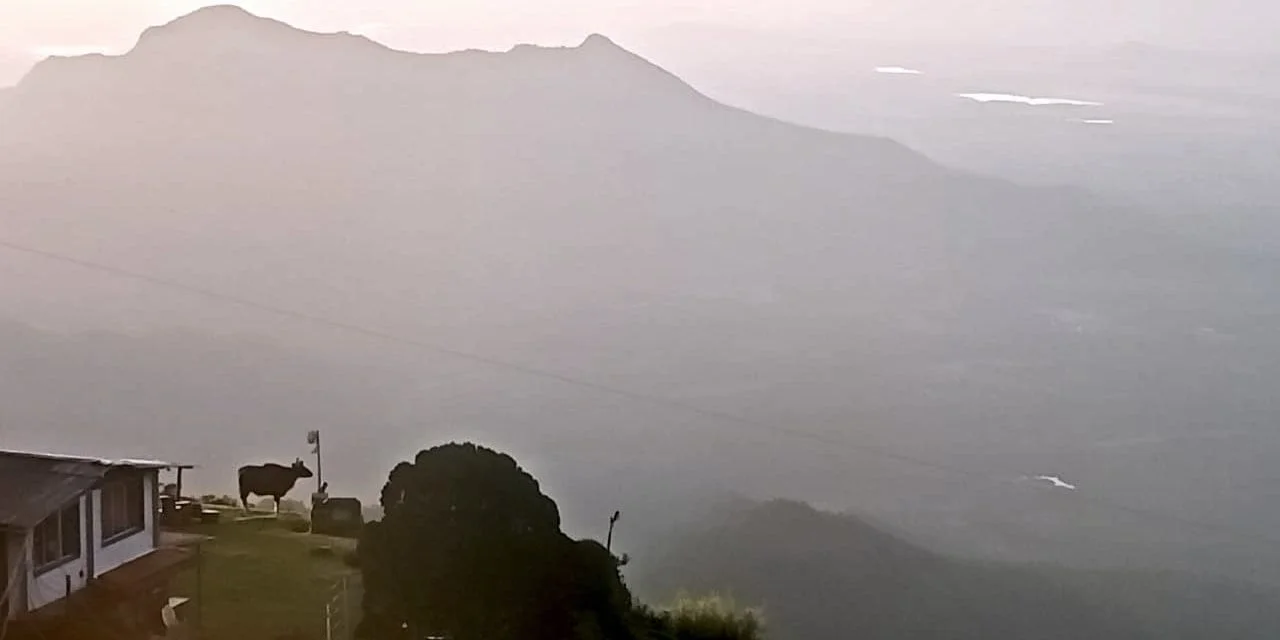It’s 7 am in the mountains, and everyone’s up. Resham, our youngest daughter, is on the lawn outside, when she spies a now familiar figure in the lower garden. It is Trog (troglodyte or loner), the large kaatu maadu or gaur who had been frequenting the neighbourhood for years now and, more recently, our own garden.
She calls out to her father to warn him about the gaur, and he sprints over to catch our dog, Django. In seconds, the gaur has turned around the corner and reaches our front door, just as Resham scrambles into the back porch to take shelter. We watched the whole incident later on the CCTV camera, and observed the loner come into view and step over the large planter with petunia and phlox, neatly avoiding the table. He then squeezes into a narrow passage, dislodging a few large boulders in the rockery, and heads towards the far end of the garden. Here he is startled by a shutting door and walks over to the bay window. We watched uneasily; our daughter Roopa and her son were just a few feet away, separated by glass. Then, we realised the animal was only staring at his own reflection. He turned then and jumped over the fence, disappearing into the early morning mist.
The Bos gaurus (Indian bison), Sus scrofa (wild boar), Erethizondor satum (porcupine), and other wild species from the forests that surround Kodaikanal have been steadily migrating to urban areas across the Western Ghats. They have been sighted in Mudumalai, Ooty, Coonoor, and Kodaikanal.

Why have these creatures of the wild—notably the majestic gaur—moved into spaces inhabited by humans?
It is difficult to get close to gaur in their natural habitat because of their nocturnal habits, but these patterns have changed for the urban dwellers. Herds of gaur can be found wandering through the marketplace, and once even at the Kodai bus stand, where a woman was reportedly attacked. In another incident in 2019, Jebbaraj from the village of Vilpatti was gored to death in his garden. This is rare, for bison attack only when they perceive a threat, especially to their calves.

Kodaikanal is surrounded by reserve forest, the habitat of many wildlife species. The sholas (tropical montane forests) and grasslands that cover the Western Ghats share a symbiotic relationship, which includes the wild creatures that inhabit these areas. With the introduction of commercial forestry during the Raj, invasive species like wattle and eucalyptus slowly decimated the grasslands that are the feeding ground of the gaur. With the decline in poaching due to stricter protection for wildlife species, and in the absence of natural predators (tigers), the population has steadily increased. This is what is widely believed to have caused the gaur migration to towns, but this makes little sense. If, as many speculate, they are in search of food and water, urban spaces have little to offer. The areas around town have slim pickings, with only small farms, backyards, and overgrown disused land for grazing.
Herds of gaur can be found wandering through the marketplace, and once even at the Kodai bus stand, where a woman was reportedly attacked. In another incident in 2019, Jebbaraj from the village of Vilpatti was gored to death in his garden
Janani Krishnamurthy, a member of the State Board for Wildlife in the Tamil Nadu Forest Department and the managing trustee of Kodaikanal’s Society for Prevention of Cruelty to Animals (SPCA), says, ‘It is obvious the gaur are attracted to something in the town area. As tourism has boomed, the mounds of garbage thrown by tourists and food waste from hotels have been an easy source of sustenance that they seem to have become addicted to—gaur have a liking for salt.’ Janani says the Forestry Board has placed salt pans and built check dams to encourage them to stay in the forests, but the ‘junk food’ available in human settlements is as addictive (and damaging) to the gaur as it is to humans. The younger generation of bison calves, she adds, have never experienced life in the grasslands.
Even up to 15 years ago, we would drive over to the Kodaikanal Golf Club, situated six kilometres from the centre of town, hoping to spot a bison or two. Once, we encountered a magnificent sight: a small herd of gaur in their prime crossing the road and jumping the high fence along the periphery of the club greens. We counted nine as they came right up to the boundary, where they jumped almost vertically, clearing the six-foot fence easily. In the deepening shadows, lit by the headlights of our car, their muscly backs glistened and rippled as powerful hind legs propelled them upwards. Their bulky bodies were at odds with their dainty, white-socked legs, and they displayed an agile jumping technique that had the elegance of fleet-footed deer and antelope in the wild.
It is obvious the gaur are attracted to something in the town area. As tourism has boomed, the mounds of garbage thrown by tourists and food waste from hotels have been an easy source of sustenance that they seem to have become addicted to—gaur have a liking for salt
Janani Krishnamurthy, member of the State Board for Wildlife in the Tamil Nadu Forest Department and managing trustee of Kodaikanal’s Society for Prevention of Cruelty to Animals (SPCA)
The greens across the clubhouse are surrounded by sholas that stretch out to Berijam Lake and beyond. The herds that roam this verdant stretch are luckier than most—streams run through the lush landscape interspersed with thickets of shola trees. Here, the animals are assured of food and water with access to acres of land uninterrupted by humans. Unlike the other gaur across town that seem a bit lost, these herds walk all over the course confidently, even on the far end, where the humans toss balls in the air and often into little holes. If I were an urban bison, this is where I would choose to live.

Vasumati Balakrishnan, an avid golfer, says the large herds of gaur that live around Kodaikanal’s Golf Course mostly ignore the presence of humans. On one occasion her group of golfers watched two males locking horns. ‘The pair were oblivious to us as they rutted, making deep grooves in the ground, not far from where we stood. Most golfers navigate their way around the animals, stop when they come too close, or even vacate the grounds if it is unsafe, which is rare. But there is the occasional incident when a bison takes us by surprise.’
Manjula Alagannan, a former resident, says her brother, Nanda, was chased up a tree on the golf course, and in another instance she and her husband had to flee from a herd with calves; on both occasions, it was probably their dogs that provoked the gaur. They escaped without incident, but others have not been as lucky and have been killed in bison attacks.

Vijay Kumar, a naturalist and trekking guide who moved to Kodaikanal in 1986 and launched Trails and Tracks, remembers the vast stretches of grassland around Pillar Rocks and Gundar Falls—perfect grazing land for bison. ‘There were herds of 30 to 40 bison found all over the sholas; now, the herds are smaller and scattered. Wattle and pine forests have spread slowly into the grasslands, destroying the fragile ecosystem, though there are some areas where shola trees have pushed back successfully. This is rare, though, and even attempts by the Forest Department at clearing wattle have mostly proved to be unsuccessful, as the hardier eupatorium have rapidly invaded the vacant space.’
Just as they do in the wild, the bison herds of Kodai seem to have demarcated their own territories, enabling the local population to aptly name them the ‘aristocrats’ of the Golf Club, the Fairy Falls herd, the old graveyard herd, the Mahalakshmi bungalow herd, the Misty Mountain herd, and so on.
Quixotically, Vera de Jong and George Penner have named the distinct loners near their home at Swedish Hill: Biff, Bob, who drowned when he fell into a well, Valentino, because of a heart-shaped marking, and Salvador Dali, because of his distinct moustache
Quixotically, Vera de Jong and George Penner have named the distinct loners near their home at Swedish Hill: Biff, Bob, who drowned when he fell into a well, Valentino, because of a heart-shaped marking, and Salvador Dali, because of his distinct moustache. Says Vera, ‘In my 14 years here, I have never stepped out in the evening without a flashlight. There is always one or more gaur right by the house.’ The vast pear orchards surrounding their home borders more orchards that connect to the sholas near Fairy Falls and along the Berijam stretch, and the area has always been a haven for gaur.

It is not uncommon to come across a gaur, generally silent, right in the centre of town; most people panic at their sight. On walks, you hear their characteristic whistling snort and sometimes their deep bellow, quite unlike domestic cattle.
Social entrepreneur Smriti Lamech, who moved to Kodaikanal last year, recounts an incident where she suddenly found herself surrounded by a herd. ‘I was walking on Fernhill Road with my headphones on, oblivious to the shouts and waving of workers nearby. I waved back, not realising they were trying to warn me, and before I knew it, I was surrounded by a herd of around 20 grazing by the side of the road, unmindful of my presence.’ After the initial panic, Smriti says she quickly took out her phone to record the moment.
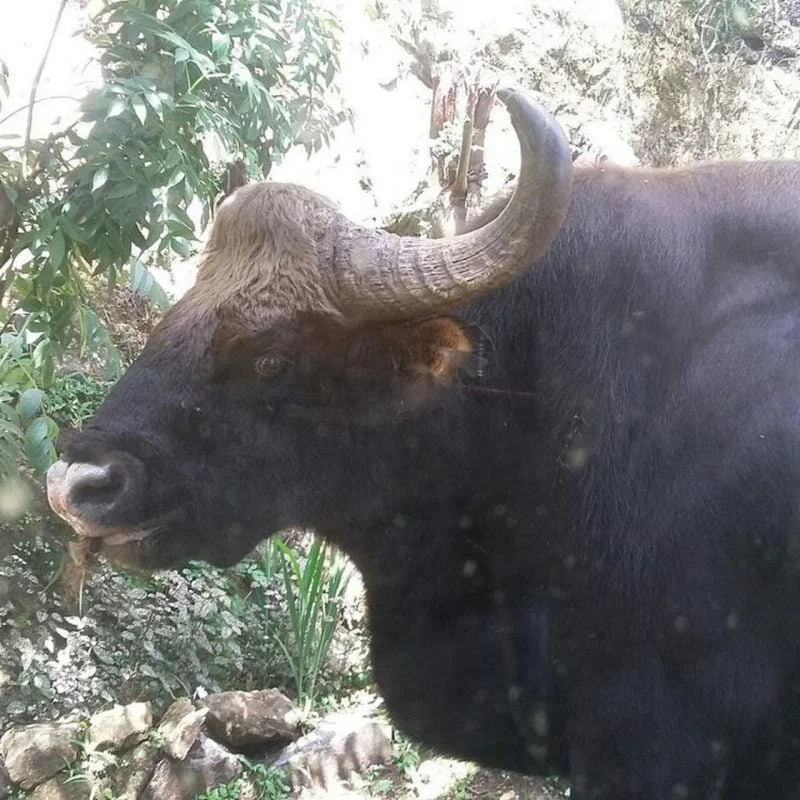
Similarly, I have seen tourists brush past a herd of gaur, obviously thinking they were large domestic cows. The herds, in turn, often just walk past crowded villages, with children playing in the streets, to join locals on walks around the lake.
Most Kodai residents have grown accustomed to their presence, shouting out to warn others when they sight gaur. Others walk by casually, for the kaatu maadu have become as familiar as domesticated cows. Velan, a farmer in my neighbourhood, tells me, ‘I frequently see gaur walking past our village, where the children play on the streets. Actually, they don’t even cause much harm to the fields, as wild boar or porcupine do. We cannot afford to lose our crops, so many farmers use rat poison, (for the boar and porcupine) which is not good. It would be better if the government can take this seriously and give us better solutions.’
P Ayammal and S Jayalakshmi, both field labourers, have had harrowing experiences. Jayalakshmi was surprised by a gaur herd and injured herself as she was fleeing; she remains wary and now takes the longer path to the fields.

A few years ago, I was surprised by Trog’s face at the kitchen window. The top of his head was just below the lintel and his large soulful eyes, fringed by bristly lashes, looked curiously at me, before he bent down to graze. Trog seemed to be old and wise, a superior animal, and if only he could speak, I imagined, there would be many stories he could tell us. Was it true—had the streams dried up? Had the familiar landscapes changed? And why had they chosen to live in crowded spaces, between human habitations, when they could be farther out in the Western Ghats, on greener pastures?
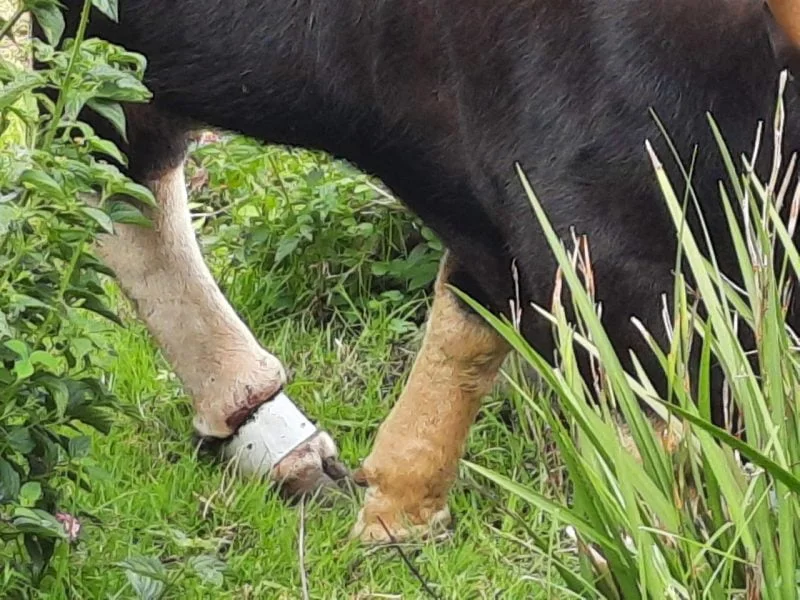
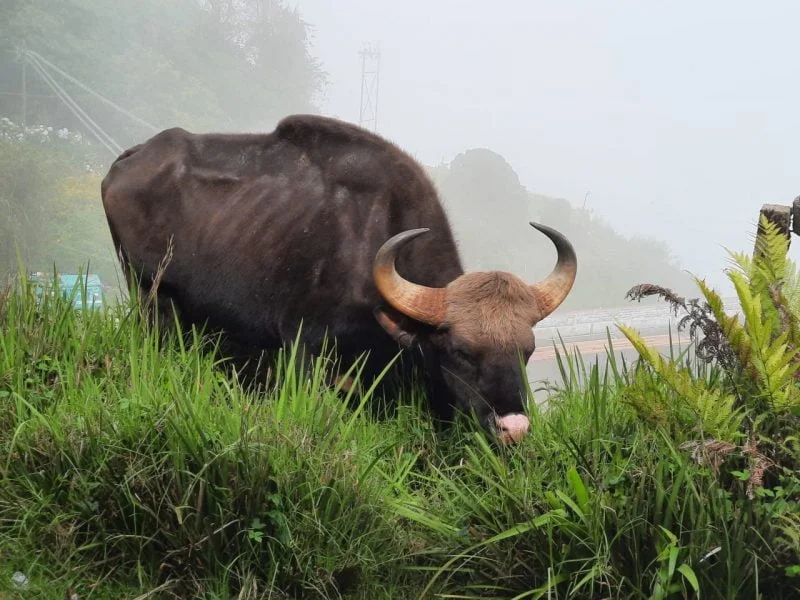
Like many humans who migrate to cities and distant lands in search of a better life, not everyone settles. Perhaps the gaur had lost their way and could be sent home. Dr VV Robin Kumar, an assistant professor at the Indian Institute of Science Education and Research (IISER) in Tirupati, does not think this is feasible. ‘Research shows that either they will just come back or other animals will move in. Research on relocating leopards in Maharashtra shows this very clearly. The only answer is to try and mitigate conflicts.’ He sent me a movie, Ajoba, that showed how relocating an old leopard was sadly not successful.
However, the patterns of different species vary, and gaur relocation could be successful with careful planning. There are reasons why the gaur should be led back to their natural habitat, besides the potential danger to humans. Gaur (like its American cousin the wild buffalo and the Bison bonasus of Europe) feed for up to 15 hours, and scatter dung while working the soil with their hooves, thereby dispersing seeds and stimulating new growth. Could the Indian gaur, like the buffalo that once roamed the Great Plains of America, have a vital role to play in carbon sequestration (as explored by Umair Irfan,2018) in the grasslands of the Western Ghats as well?
Grassland ecosystems are in danger everywhere and are particularly vulnerable to the effects of human-induced climate change. If the bison were returned to their natural landscape, the regeneration of grasslands could enhance the ability of the soil to hold more carbon dioxide, and thus act as a natural carbon storage facility. For this reason, bison were reintroduced to the grasslands across Europe, recognising their role as ‘keystone species’ for grassland management (as explained in ‘The return of European Bison’).
Ecologist Allan Savory, who advocates ‘holistic management’, says, ‘By mimicking the natural movements of the ruminants that once roamed the earth, the animals become part of a cycle that can restore over-grazed land to its natural state, sequestering carbon, regenerating grasslands, and thereby slowing climate change and even possibly reversing it.’

The butterfly effect (the idea that small things can have an indirect impact on complex issues) of gaur returning to their natural habitat may not cause a sudden reversal of climate change, but it could be one of the catalysts. In the case of gaur, rewilding has not been attempted yet in India.
While some argue that the grasslands should be first regenerated to persuade the gaur to stay on, there is also the possibility that natural regeneration will follow once the herds of gaur are back.

Other visitors who seem to have a penchant for ‘urban living’ are the marauding wild boar, porcupine, langur, and occasional leopard, all destructive to farmers besides being dangerous. More delightful settlers are the Nilgiri tahr, the flying squirrel, wild hare and an assortment of birds that have migrated to urban areas. According to local farmers, it is only the kaatu maadu that find cosy spots to camp in, within human settlements. The rest—wild boar, porcupines, leopards, and deer—are occasional or frequent visitors from nearby forests. In 2020, the Environment and Forests Department of Tamil Nadu gave into pressure from farmers and issued a government order for culling wild boar in 11 forest divisions, where they were destroying crops. Different solutions will have to be found for porcupine and other species, but if gaur relocation is successful, it is possible that other species will follow.

Recently, several locals have reported sighting peafowl, that normally inhabit the plains, in their gardens. Dr Kumar, who is a member of Shola Sky Islands, a group of environmentalists who study biodiversity through bird ecology, explains, ‘This phenomenon of the [peafowl]species being found in higher elevations is occurring across many Western Ghat areas.’ He showed me a study that explored the patterns observed in Kerala. ‘Climate change may be driving the upslope movement of some of these species. The above may not be happening independently, as it may also be concurrent with landscape change with increasing agriculture.’ Additionally, he points out that all species may not be driven to move from their habitat for the same reason.
‘The gaur issue is tricky. More research is needed on their movements. Till then, we have to learn to live with them,’ says Dr Kumar.
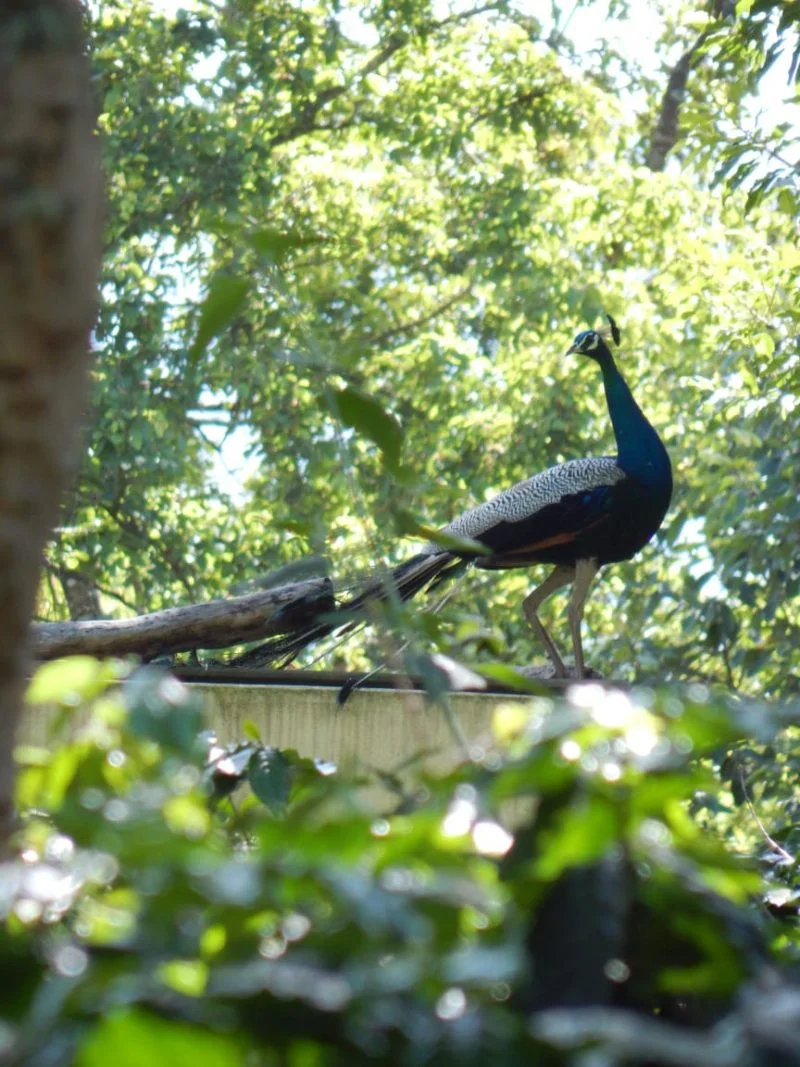
Earlier this year, a neighbour heard a loud thud outside her home early one morning. It was still pitch dark, and nothing could be seen. By 6 am, it was discovered that a large gaur had fallen through the roof into their rainwater harvesting tank and drowned. Instinctively, I knew it was Trog, the loner. And indeed, he was never seen again.
Included in Schedule 1 of the Wildlife Protection Act, 1972, and listed as ‘vulnerable’ in the International Union for Conservation of Nature (IUCN) Red List, gaur, often called bison or kaatu maadu (wild cow), inhabit the grasslands and sholas of the Western Ghats. Gaur typically move in groups of 5 and above, even up to 30 fully grown males and females with calves. The males often walk alone, and it is believed that the oldest bulls are solitary by nature. Fully grown, the males can be up to 7.5 feet tall and weigh over a ton, the females marginally less. The average gaur, whose diet consists of grass, leaves, and tender shoots, feed for 10–15 hours a day.

